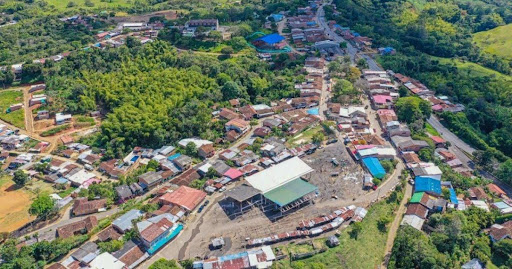SANTANDER DE QUILICHEO
Department

Flag of the city
The flag of the city is colored red, with yellow triangle extending to the center from the left hand side. It is a representation of the city’s cultural value and heritage.


Slogan of the city
The city does not have a specific slogan. However, the motto of its department, Cauca, is “For the right to a difference”. This statement signifies distinction and uniqueness.
History

Santander de Quilichao, a municipality in the Cauca Department of Colombia, traces its history through a series of significant developments that have shaped its identity. The name “Santander” was formally bestowed upon the municipality in 1827, a gesture of appreciation towards Francisco de Paula Santander, the Vice President of the Republic. The town’s origins are multifaceted, with one account suggesting a foundation by Sebastián de Belalcázar in 1543, initially named Jamaica and later becoming Villa de Quilichao. Another perspective posits a gradual formation around an existing indigenous village and chapels constructed by missionaries, without conventional legal requirements for a civil or military foundation. The colonial period witnessed the establishment of real mines in the Quilichao district, worked by enslaved individuals of African descent. San Antonio de Quilichao attained the status of Villa in 1755 under Viceroy Solís. Haciendas awarded to the Jesuits were later auctioned off, contributing to the rise of local landowner-miners who vacillated between allegiance to Spain and the patriot forces during the struggle for independence. The abolition of slavery in 1851 marked a significant social shift, with formerly enslaved individuals progressively becoming owners of real mines by 1857. Economic dynamics underwent transformation in the mid-20th century, as the sugar cane industry gained prominence in northern Cauca. Sugar mills like La Cabana and Incauca emerged, leading to a substantial increase in the cultivation of sugar cane. Santander de Quilichao’s history reflects the intricate interplay of indigenous heritage, colonial influences, economic endeavors such as mining and agriculture, and its pivotal role in the broader context of Colombian independence.
Geography of the city
Santander de Quilichao is located at coordinates 3°00′30″N latitude and 76°29′02″W longitude in the Cauca Department of Colombia. The municipality covers a total surface area of 518 km². The average altitude of Santander de Quilichao is 1,071 meters above sea level, providing the town with a moderate elevation. As of 2023, Santander de Quilichao is home to a population of 115,745 inhabitants. The density of the population is approximately 223.68 inhabitants per square kilometer. Within the municipality, the urban area of Santander de Quilichao is inhabited by 53,049 people, contributing significantly to the overall population distribution.

Population
Total – 115,745 inhabitants (2023)
Urban – 53,049 inhabitants (2023)
One photo representative of the city
The city has various attraction centers with beauty to behold. These include Pink Lake or Laguna Rosada; El Sagú; Las Delicias; Caños Negros Waterfalls, and many more.

Etymology
The name “Quilichao” has sparked various interpretations regarding its origin and meaning. One hypothesis suggests that it is derived from the Pijao language, where “ao” signifies “gold,” and “quilich” translates to “land.” Hence, the interpretation suggests “Land of Gold,” linking the name to the historical gold exploitation along rivers like Quinamayo, utilizing black slaves. Another hypothesis explores the Nasa Yuwe language (Paez), proposing a combination of roots: “tyicli,” meaning “tiger,” and “ciao” or “ksha’w kʃaʔw,” meaning “dream.” This combination evolves into “Quilichao,” signifying “Tiger’s Dream.” The Nasa indigenous people attribute this name to a ritual where traditional doctors dreamt of tigers. Furthermore, a tradition from the 12th century associates the name with its ancient indigenous settlers, where “Quilichao” supposedly means “Land of Gold.” Lastly, an alternative hypothesis suggests an evolution from the indigenous term “kilishara,” meaning “passage house”.
What the city is known or famous for
Santander de Quilichao stands as a testament to its rich historical and cultural tapestry. Founded in the 18th century, the city’s name carries a deep significance, granted in honor of Francisco de Paula Santander, the Vice President of the Republic during the 19th century. The city’s roots intertwine with its indigenous heritage, particularly the Nasa (Paeces) people, who have contributed to the vibrant cultural fabric. The name “Quilichao” is believed to have indigenous origins, potentially meaning “Land of Gold” or reflecting the intriguing ritual of dreaming about tigers. Santander de Quilichao boasts a storied past in mining, with a legacy of gold exploitation along its rivers, notably Quinamayo. This historical association earned the city the moniker “Land of Gold,” highlighting its natural wealth and the economic activities that evolved over time. The city’s unique cultural identity is further enriched by rituals, such as the indigenous practice of dreaming about tigers, adding a mystical dimension to its character. Over the years, Santander de Quilichao has witnessed the growth of its mining industry, initially established during the colonial period and later transitioning to diverse economic pursuits.

